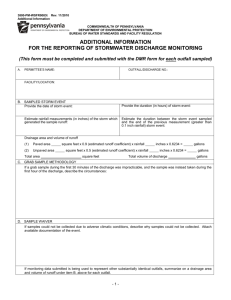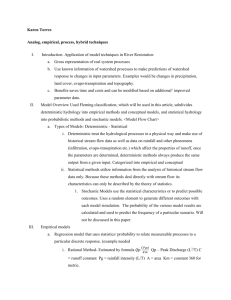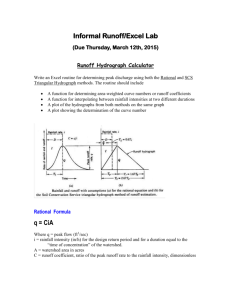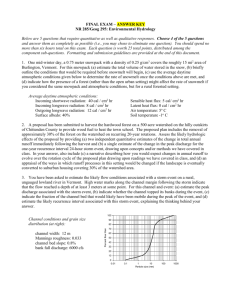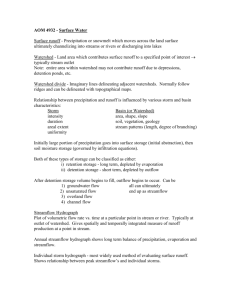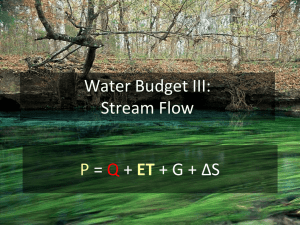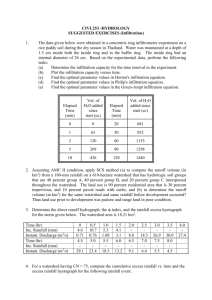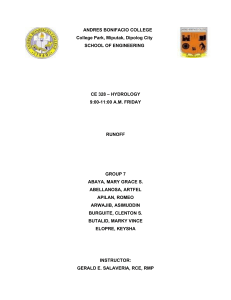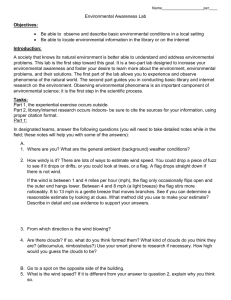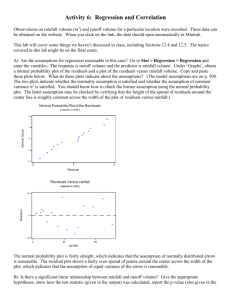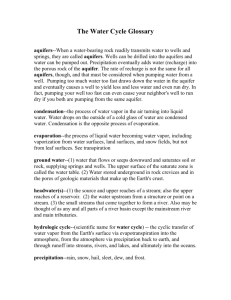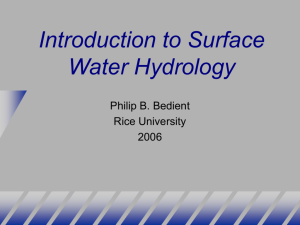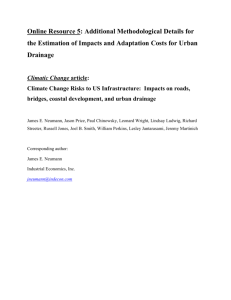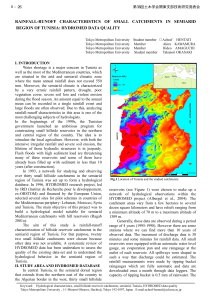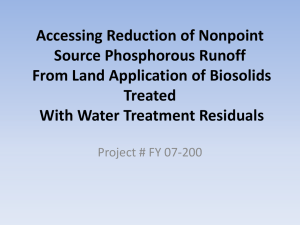Exam 2 CB
advertisement
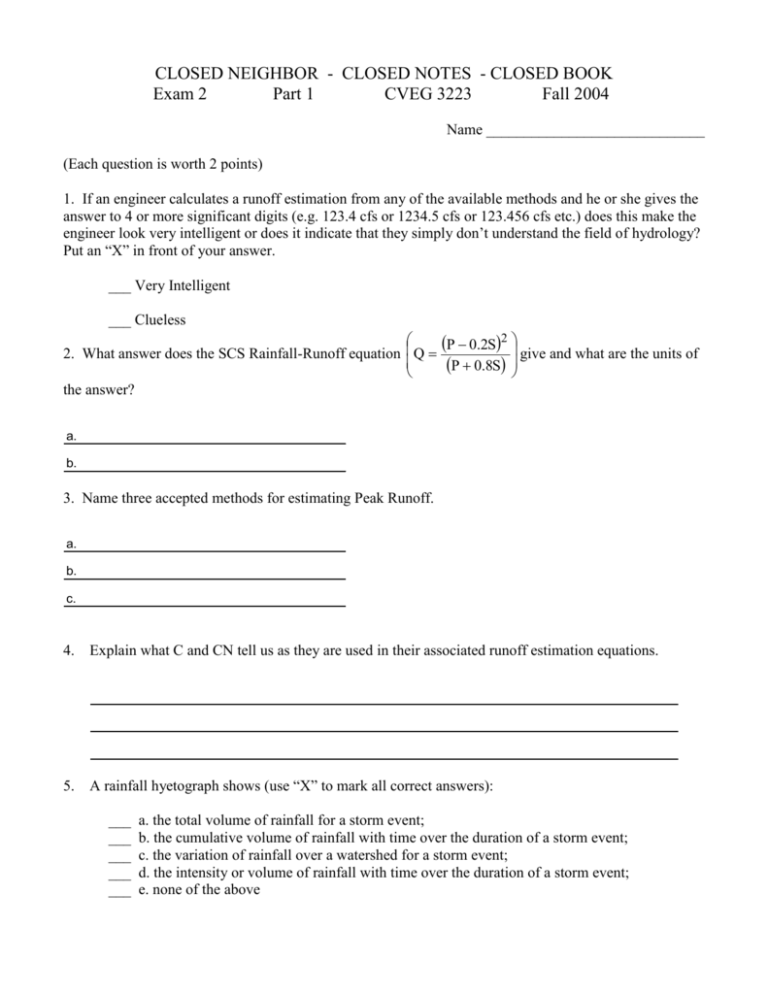
CLOSED NEIGHBOR - CLOSED NOTES - CLOSED BOOK Exam 2 Part 1 CVEG 3223 Fall 2004 Name _____________________________ (Each question is worth 2 points) 1. If an engineer calculates a runoff estimation from any of the available methods and he or she gives the answer to 4 or more significant digits (e.g. 123.4 cfs or 1234.5 cfs or 123.456 cfs etc.) does this make the engineer look very intelligent or does it indicate that they simply don’t understand the field of hydrology? Put an “X” in front of your answer. ___ Very Intelligent ___ Clueless P 0.2S2 give and what are the units of 2. What answer does the SCS Rainfall-Runoff equation Q P 0.8S the answer? a. b. 3. Name three accepted methods for estimating Peak Runoff. a. b. c. 4. Explain what C and CN tell us as they are used in their associated runoff estimation equations. 5. A rainfall hyetograph shows (use “X” to mark all correct answers): ___ ___ ___ ___ ___ a. the total volume of rainfall for a storm event; b. the cumulative volume of rainfall with time over the duration of a storm event; c. the variation of rainfall over a watershed for a storm event; d. the intensity or volume of rainfall with time over the duration of a storm event; e. none of the above 6. In hydrology, why do we calculate the time of concentration for a watershed? 7. What is the graph below used for? 100 Percent of Point Rainfall for Given Area 24 hr duration 90 12 hr duration 6 hr duration 80 3 hr duration 2 hr duration 70 1 hr duration 60 30 min duration 50 0 50 100 150 200 250 300 Area (mi2) 8. Given the site below, what is the time of concentration at the following points? Point C Point D Point E tc = _________ tc = _________ tc = _________ Subbasin 1 A = 5 acres C = 0.5 tc = 7 min Subbasin 3 A = 6 acres C = 0.3 tc = 14 min Subbasin 2 A = 6 acres C = 0.4 tc = 11 min C E D inlet to channel (typical of 3) Channel 1 t travel = 2 min Channel 2 t travel = 4 min 350 400 9. Explain how the following type of equation is developed. Q 2.35A 0.41SL0.17 RI 2 32.04 ST 8 0.65 13 BDF 0.32 IA 0.15 10. The equation Q CAh 0.5 is typically used to model: ___ flow through an orifice ___ flow in a pipe ___ flow over a weir ___ flow in an open channel . 11. Hydrologic soil groups (A, B, C, & D) are used primarily to take into account what soil characteristic? 12. What would you expect to happen to the runoff characteristics of an area after it is developed (roads and buildings are constructed)? (“X” ALL that probably apply) ___ The total amount of runoff would increase. ___ The time of concentration would decrease. ___ The velocity of the runoff would decrease. ___ The peak runoff flowrate would increase. ___ None of the above 13. What is the key underlying model used to calculate time of concentration for sheet flow, shallow flow and channel flow? (Hint: we ain’t talkin’ about, v = L/t – which is NOT a model) 14. If you needed to analyze the frequency of the mass of a pollutant that is transported past a point in a stream during storm events, would it be reasonable to use the statistical methods outlined in Chapter 5 (plotting pollutant yield vs exceedence probability)? Why not or why? ___ Yes ___ No Because - 15. In the City of Fayetteville Stormwater Management and Erosion Control Plan Submittal Procedures, the Final Drainage Report Checklist gives 30 items that must be included in a Final Drainage Report for any development. What are the general categories of information that those thirty items would fall into. (I have given you 10 spaces; but, you do not necessarily need all ten). If a category name you list is not self evident as to what type of information would go into that category, give some examples. a. b. c. d. e. f. g. h. i. j. 16. Beside each type of surface, write the corresponding letter (a, b, c, or d) for the most probable Manning’s n value: A. ___ Dense underbrush a. biggest n (0.8) B. ___ Glass b. almost biggest n (0.2) C. ___ Bare earth, concrete c. almost lowest n (0.1) D. ___ Long grass d. lowest n (0.01) 17. Draw a line in the general direction (trending upward, flat, trending downward, middle pointed upward, middle pointed downward, middle pointed to the right, middle pointed to the left) you would expect for a typical DDF curve. Precipitation (in) 10 1 0.1 0.01 0.1 1 10 100 Duration (hrs) 18. In developing the SCS Rainfall-Runoff relation, the total rainfall was separated into three components. Place an “X” beside any of the following that are those components. ___ antecedent soil-moisture ___ initial abstraction ___ direct runoff ___ base flow 19. Which of the following are factors in directly estimating CNs for urban land uses? Place an “X” beside any of the following that apply.) ___ soil type ___ percent imperviousness ___ percent of unconnected imperviousness ___ percent of the watershed that is sewered ___ time of year ___ all of the above 20. Delineate the drainage basin for the point A (yellow dot) in the map below.


